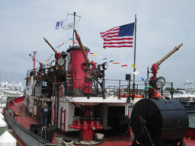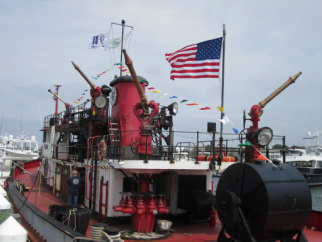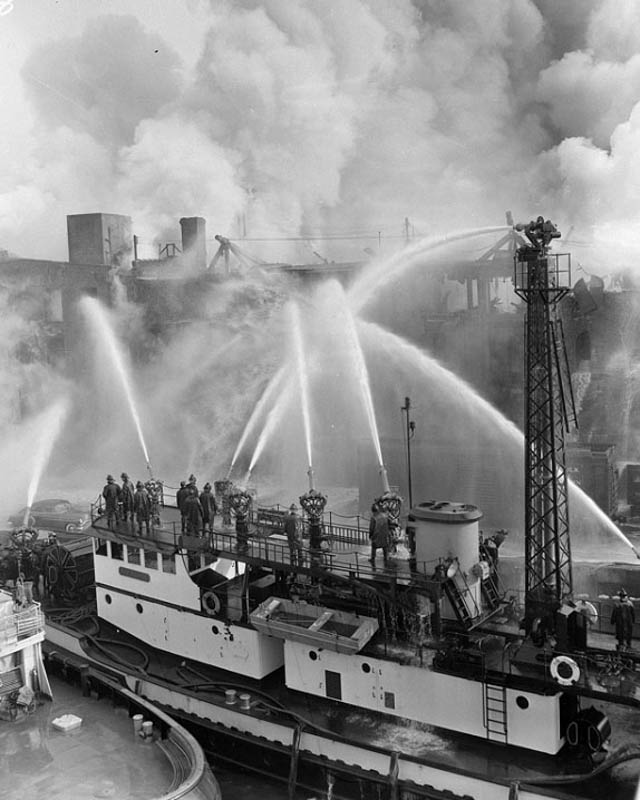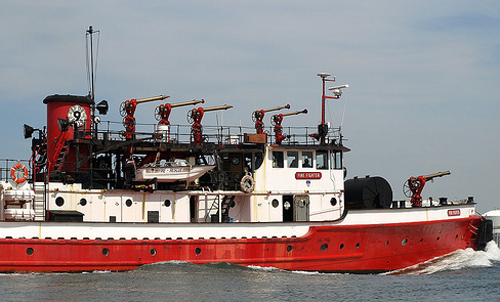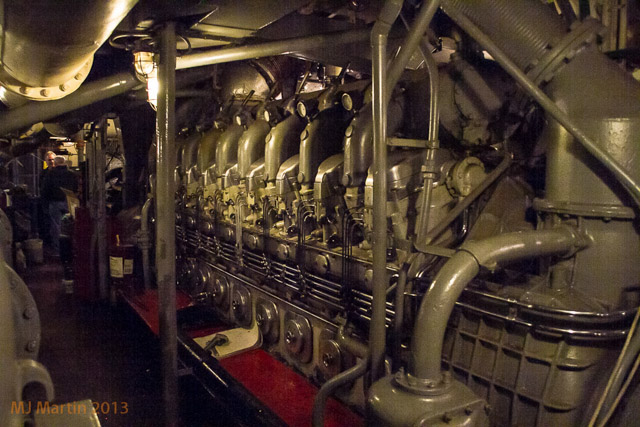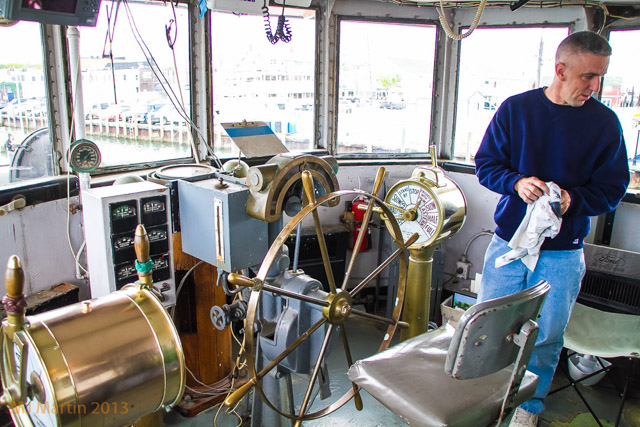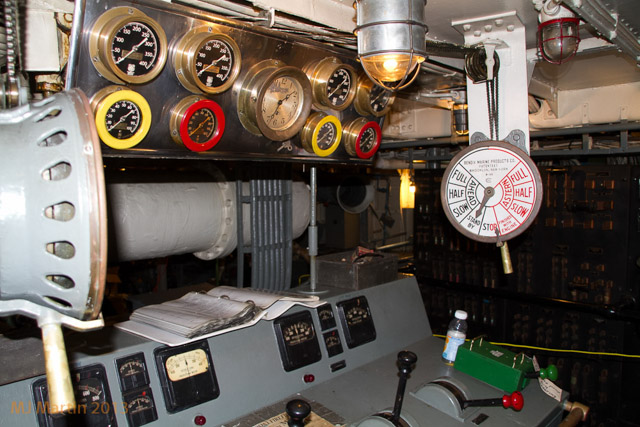In front-line service for over seven decades protecting New York Harbor, Fire Fighter has the hard-earned distinction of being the most decorated fireboat in the world, and at the time of her 2010 decommissioning she was the second oldest fireboat in front-line service worldwide. As a National Historic Landmark and listed on the National Register of Historic Places, the Fire Fighter is a truly significant piece of American history.
In the late 1930's due to the looming war in Europe and highlighted the need for a modern and more powerful fireboat to protect the harbor. Seizing the opportunity to fuse two of his interests into one project, noted naval architect William Francis Gibbs approached Mayor Fiorello LaGuardia with an ambitious design proposal for a revolutionary fireboat with an unrivalled pumping capacity and the first diesel-electric propulsion system ever mounted in a FDNY fireboat.
In the late 1930's due to the looming war in Europe and highlighted the need for a modern and more powerful fireboat to protect the harbor. Seizing the opportunity to fuse two of his interests into one project, noted naval architect William Francis Gibbs approached Mayor Fiorello LaGuardia with an ambitious design proposal for a revolutionary fireboat with an unrivalled pumping capacity and the first diesel-electric propulsion system ever mounted in a FDNY fireboat.
Mayor LaGuardia eagerly approved Gibbs’ proposal and in the fall of 1937 the keel of Hull #856 was laid at United Shipyards on Staten Island. Built of riveted steel and measuring 134ft long with a 32ft beam housing a pair of General Motors 1500hp 16-cylinder 3968 CID Winton Diesel Engines, the vessel taking shape on the ways was by far the world’s most powerful fireboat; with four DeLaval two-stage centrifugal pumps driven by four Westinghouse Marine DC 600hp motors capable of delivering up to 20,000 gallons per minute of water to the nine topside fire monitors and hose manifolds. With construction wrapping up on Hull #856 in the late summer of 1938, the vessel was formally Christened as the Fire Fighter by Miss Eleanore Grace Flanagan, the daughter of a fireboat officer, on August 28th, 1938 and slid down the ways into Newark Bay. Heralded as a utilitarian vessel by Mayor LaGuardia, the name Fire Fighter was intended to honor the men of the FDNY, and not a Mayor of New York City as was the tradition with previous FDNY fireboats. Spending much of her first month of operation engaged in extensive training to familiarize her crews with her substantial capabilities, the Fire Fighter officially entered FDNY service at 0900hrs on November 16th, 1938 with Engine 57 at Pier 1 in the Battery.
|
With the presence of so many ammunition-laden cargo vessels, fuel-laden tankers and cargo-laden transports crowding the harbor with warships of every description all but guaranteeing a major open-water mishap, the majority of the Fighter’s wartime fire calls instead came from vessels in distress while pier-side. With the risk of fire aboard a general cargo ship or in a pier shed already high for litany of reasons prior to the war, the subsequent demand for raw materials in Europe meant that most breakbulk freighters and pier houses were loaded and often times overloaded with multiple types of cargo, most of which did not “get along” or even worse provided a fuel source in the event of fire. As a result, time and again along the wartime waterfront small fires that would have otherwise been contained quickly grew into raging infernos that claimed ships, property and lives.
|
|
Such was the case in August of 1941, when the Fighter was dispatched to fight a catastrophic and multiple-fatality fire aboard the freighter SS Panuco at Brooklyn’s Pier 27 at the foot of Warren Street.
Months later, a surprising call came from Pier 88 Finding the troophip USS Lafayette formerly the ocean liner Normandie engulfed in flames. Fire Fighter joined almost every fireboat in the FDNY fleet in battling the blaze and unleashed her full pumping capacity to extinguish the numerous fires burning on the enormous ship. Successful to a fault, Fire Fighter certainly contributed her share to the huge volume of water pumped aboard the burning liner which eventually caused it to capsize, nearly crushing the Fire Fighter beneath her as she suddenly began parting her mooring lines and rolling onto her Port side. |
Called upon slightly over a year later to battle yet another major vessel fire, the Fighter was dispatched on April 26th, 1943 with the fireboat John J Harvey the Caven Point Army Terminal pier where a fire had broken out aboard the fully-loaded freighter SS El Estero. Arriving onscene to news that the ship was carrying a mixed load of explosives weighing some 5,000 tons, Fire Fighter’s crew ignored the clear and imminent danger posed by the detonation of the ship’s cargo and immediately set about drowning her flaming cargo with huge amounts of sea water. Using her stern-mounted tower monitor to its designed purpose of reaching over vessel bulwarks and into cargo holds, Fire Fighter eventually succeeded in pulling the burning ship off the pier and onto Robbins Reef, where she and the Harvey used their combined 38,000gpm pumping capacity to sink the El Estero in shallow water, thus ending what is perceived to have been the single greatest threat to New York Harbor during the entire Second World War.
Battling major pier fires in 1946, 1947, 1956 and 1964, Fire Fighter’s crew became well-drilled to the process of “deconstructing” the large, wooden pier houses which were often packed to the rafters with cargo of all varieties; either by using her bow-mounted 5-inch monitor to physically batter down the structure or by using her powerful onboard air compressor and jackhammers to create fire breaks in pier floors. With these types of fires on the rise through the 1950’s and culminating with the massive explosion at the December 3rd, 1956 Lukenbach Steamship 35th Street Pier that badly damaged the Fire Fighter and wounded most of her crew along with several hundred civilians, both the City of New York and the Fire Department began to crack down on pier operators to ensure proper fire prevention apparatus was in place. These new regulations and their requisite costs came at a dire time for most steamship lines that were already operating at razor-thin profits due to foreign competition and the rise of containerization among cargo shippers, and during the 1960’s many began to merge, shut down or move to less expensive ports.
Battling major pier fires in 1946, 1947, 1956 and 1964, Fire Fighter’s crew became well-drilled to the process of “deconstructing” the large, wooden pier houses which were often packed to the rafters with cargo of all varieties; either by using her bow-mounted 5-inch monitor to physically batter down the structure or by using her powerful onboard air compressor and jackhammers to create fire breaks in pier floors. With these types of fires on the rise through the 1950’s and culminating with the massive explosion at the December 3rd, 1956 Lukenbach Steamship 35th Street Pier that badly damaged the Fire Fighter and wounded most of her crew along with several hundred civilians, both the City of New York and the Fire Department began to crack down on pier operators to ensure proper fire prevention apparatus was in place. These new regulations and their requisite costs came at a dire time for most steamship lines that were already operating at razor-thin profits due to foreign competition and the rise of containerization among cargo shippers, and during the 1960’s many began to merge, shut down or move to less expensive ports.
|
Responding immediately to the sight of the burning North Tower of the World Trade Center, Fire Fighter joined the entire FDNY Marine Unit at the Battery where her crew initially made the boat ready to provide hoses and a staging area for FDNY operations battling what seemed to be a terrible accident. The impact on the South Tower at 0903hrs and the subsequent collapse of the World Trade Center changed everything, and like her fellow fireboats the Fire Fighter and her crew spent the next three days pumping at full capacity through her deck manifolds to supply water for firefighting efforts at Ground Zero.
Literally worn out by her marathon pumping duty, the Fire Fighter was ordered into the shipyard for a much-needed overhaul and full inspection. Found to be fit for several more years of service despite her advancing age, the clear need for modern counter-terrorism capabilities among New York City’s emergency responder apparatus brought about design requirements that Francis Gibbs could not have foreseen; particularly the capability to operate in areas exposed to chemical, biological and nuclear contaminants. With retrofitting the ageing vessel proving to be cost-prohibitive, the daunting and nearly decade-long task of designing and building a suitable replacement for the Fire Fighter began. Despite her front line service days clearly being numbered, Fire Fighter still maintained her watch over the Verrazano Narrows and kept up a busy schedule of calls in her last decade on duty. Fighting her last major vessel fire on February 21st, 2003 following the explosion of a fully-loaded gasoline barge at Port Mobile, New York, Fire Fighter also played major roles in the emergency response to the October 2003 Staten Island Ferry Disaster and the ditching of US Airways Flight 1549 in January 2009. |
Fire Fighter’s 72-year FDNY career came to an end shortly
after the arrival of her replacement- appropriately named Fire Fighter II.
To prevent Fire Fighter being scrapped a private group was formed to save this valiant fire-boat.
They are now a verified 501c3 non-profit museum group of volunteers dedicated to preserving
Fire Fighter as a fully operational museum ship and memorial.
The Fire Fighter is currently berthed at the commercial dock in the village of Greenport,
NY and is open each weekend for visitation and volunteer restoration work.
The effort to save Firefighter has reached a critical stage and
this group is asking your help so that this work can be continued.
Please visit
http://fireboatfirefighter.org/
and consider honoring all who responded September 11th 2001 -by making a donation.
With thanks to those who helped out when my boat SV Loon needed help southbaysail.com has set aside some of
our first year receipts to supplement your donations. If you can help please let us know at info@southbaysail.com
and we will add to your donation
our first year receipts to supplement your donations. If you can help please let us know at info@southbaysail.com
and we will add to your donation
|
share this with friends...
|
|
